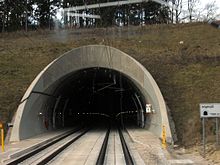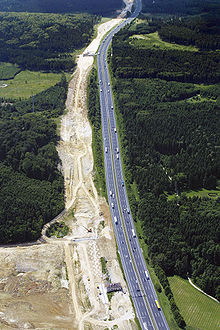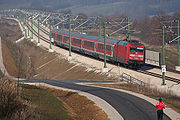- Nuremberg–Munich high-speed railway
-
Nuremberg–Munich high-speed railway 
The Irlahülltunnel (7,260 m/23,819 ft) is one of the longest and steepest (20 permille) rail tunnels in GermanyLine number New line: 5934; Old line: 5501 Technical Line length 170.8 km Minimum radius 300 km/h section: 4085 m
Upgraded track: 814 mOperating speed 300 km/h, upgraded track: 200 km/h Maximum incline 300 km/h section: 20 ‰ (300 km/h section)
Upgraded track: 12.5 ‰Route map The Nuremberg–Munich high-speed railway line is a German high-speed railway 171 km (106 mi) in length. It links the two largest cities in Bavaria, Nuremberg and Munich.
The northern section, between Nuremberg and Ingolstadt, is a new 300 km/h (186 mph) track built from scratch between 1998 and 2006. It is 90.1 km (56.0 mi) in length with nine tunnels (total length: 27 km/17 mi). In order to minimize damage to the environment, it runs for the most part right next to Bundesautobahn 9.
The southern section, between Ingolstadt and Munich, is 19th-century track. Its southern section has been upgraded for up to 200 km/h (124 mph). Between 2010 and 2013, further upgrades to the mid section of the track will be done. The minimum speed on the Munich-Ingolstadt section should then be 160 km/h (99 mph), with 190 km/h (118 mph) in the middle and 200 km/h in the southern section.
Both long-distance and regional services operate on the line. InterCityExpress trains reach the tracks' 300 km/h speed-limit. InterCity and RegionalExpress trains travel at a maximum speed of 200 km/h. The Allersberg-Express, a RegionalBahn shuttle service, is operated between Allersberg and Nuremberg.
The line was officially inaugurated on May 13, 2006. Limited operation with a twice-hourly long-distance service started on May 28, 2006. The line has been in full operation since December 2006. Compared to the former track via Augsburg, it cut off 29 km (18 mi), or about 30 minutes journey time on long-distance and an hour on regional trains.
Most of the track is equipped with Linienzugbeeinflussung and GSM-R. ETCS will be introduced in 2009. The total costs (as of January 2006) were about € 3.6 billion.
The line is part of the Line 1 of Trans-European Transport Networks (TEN-T).
History
The Munich–Ingolstadt line was opened in 1867 and was extended to Treuchtlingen as the Ingolstadt–Treuchtlingen line in 1870.
The first proposal for a high-speed line dates back to 1983, when the Nuremberg section of Deutsche Bundesbahn proposed a more direct line between Nuremberg and Munich. The project was added to the 1985 federal traffic infrastructure plan. The following years were marked by heated debate on the route of the line, in particular if it should run via Ingolstadt or Augsburg. While the Ingolstadt line is much more direct (171 km) than the existing Augsburg route (199 km/124 mi), the metropolitan area of Augsburg is considered much larger than Ingolstadt's. Apart from concerns that fewer long-distance trains would run via (and stop at) Augsburg, there were also concerns about the environmental effects of the 75 km (47 mi) of track that had to be built from scratch. Large-scale construction began in 1998, when numerous disputes had finally been settled and the total cost was estimated to be € 2.3 billion. The € 1.3 billion cost increase arose from numerous geological problems found during construction and additional works required to meet environmental and security concerns.
On September 2, 2006, ÖBB locomotive 1216 050 (a Siemens Eurosprinter) set a new world record for locomotives with a top speed of 357 km/h (222 mph); reached near Hilpoltstein.
Nuremberg–Ingolstadt–Munich
high-speed railway lineMajor stations and engineering works Legend
100.6 Nuremberg Hauptbahnhof 
see Nuremberg–Regensburg railway 
from Nuremberg marshalling yard 
91.0 9.6 Nürnberg Reichswald junction 
Nuremberg–Regensburg line 
9.8 Beginning of new line 
10.6 A6 
11.2 to Regensburg 
15.0 Schwarzach viaduct (104 m) 
15.5 A73 (Nürnberg/Feucht interchange) 
25.4 Allersberg (Rothsee) 
29.0 Göggelsbuch tunnel (2287 m) 
33.6 Main-Danube Canal (141 m) 
40.5 Offenbau tunnel (1333 m) 
42.4 Lohen signal box 
47.2 Staatsstraße 2227 near Großhöbing (305 m) 
49.1 Euerwang tunnel (7700 m) 
57.7 Anlauter 
57.8 Schellenberg tunnel (650 m) 
58.6 Kinding (Altmühltal) 
59.4 Altmühl (79 m) 
59.6 Irlahüll tunnel (7260 m) 
67.6 Denkendorf tunnel (1925 m) 
76.0 Stammham tunnel (1320 m) 
78.1 Geisberg tunnel (3289 m) 
85.0 Audi tunnel (1258 m) 
86.8 Ingolstadt Nord End of new line 
87.0 84.3 interweaving of Treuchtlingen–Munich line (3 tracks) 
84.3 from Treuchtlingen 
83.4 Ingolstadt railway bridge over the Danube (184 m) 
81.0 Ingolstadt Hauptbahnhof 
Beginning of upgraded line 
78.4 Paar Valley Railway (track towards Ingolstadt) 
77.1 Oberstimm 
74.4 Ebenhausen factory siding 
72.4 Reichertshofen (Oberbayern) 
71.0 Paar 
67.8 A9 
66.4 Hög 
Ilm 
60.6 to Wolnzach Markt (freight only) 
60.2 Rohrbach (Ilm) four tracks (outside tracks) 
58.4 A9 
55 Walkersbach 
54.6 Üst Uttenhofen (crossover) 
49.7 Pfaffenhofen (Ilm) three tracks plus sidings 
43.8 Reichertshausen (Ilm) viergleisig (Außenbahnsteige) 
40.2 Paindorf 
36.4 Petershausen (Oberbayern)  terminus
terminus
34.8 Glonn 
27.1 Röhrmoos three tracks 
24.1 Viaduct near Reipertshofen (141 m) 
to Altomünster 

Amper 
17.8 Dachau  terminus
terminus
14.2 München-Karlsfeld four tracks 
13.6 to Munich North marshalling yard (double track) 
10.4 München-Allach four tracks 
5.3 Kanal junction to Munich–Regensburg railway 
0.0 Munich Hauptbahnhof 






 , terminus of
, terminus of 
Trains running on the Nuremberg–Munich high-speed railway An ICE 1 at 250 km/h (155 mph) near Kinding.In July 2006, a French TGV undertakes a 330 km/h (205 mph) test ride for technical approval in Germany.At a top speed of 200 km/h (124 mph), the München-Nürnberg-Express is the fastest regional train in Germany.See also
External links
Berlin–Halle · Halle/Leipzig–Erfurt · Erfurt–Nuremberg · Nuremberg–Munich · Munich–Rosenheim · Rosenheim–Kufstein · Kufstein–Wörgl · Wörgl–Innsbruck · Innsbruck bypass · Innsbruck–Franzensfeste (Brenner Base Tunnel) · Franzensfeste–Verona · Milan/Verona–Bologna · Bologna–Florence · Florence–Rome · Rome–Naples · Naples–Salerno · Salerno–Reggio Calabria(it) · Strait of Messina Bridge · Messina–Palermo(de) ·
High-speed railway lines East Asia JapanChinaBeijing-Shanghai · Qinhuangdao–Shenyang · Hefei–Nanjing · Beijing–Tianjin · Qingdao–Jinan · Shijiazhuang–Taiyuan · Hefei–Wuhan · Ningbo–Taizhou–Wenzhou · Wenzhou–Fuzhou · Wuhan–Guangzhou · Zhengzhou–Xi'an · Fuzhou–Xiamen · Chengdu–Dujiangyan · Shanghai–Nanjing · Nanchang–Jiujiang · Shanghai–Hangzhou · Hainan Eastern Ring · Changchun–JilinSouth KoreaGyeongbu HSRTaiwanEurope BelgiumFranceLGV Sud-Est · LGV Est · LGV Atlantique · LGV Rhône-Alpes · LGV Nord · LGV Interconnexion Est · LGV Méditerranée · Perpignan-FigueresGermanyCologne–Düren · Cologne–Frankfurt · Hanover–Würzburg · Mannheim–Stuttgart · Rastatt–Offenburg · Wolfsburg–Berlin · Nuremberg–IngolstadtItalyNetherlandsNorwaySpainMadrid–Barcelona · Madrid–Sevilla · Córdoba–Malaga · Madrid–Valladolid · Madrid–Toledo · Figueres–Perpignan · Madrid–Valencia · Motilla–AlbaceteTurkeySincan–Eskişehir · Polatlı–KonyaUnited KingdomNorth America United StatesCategories:- High-speed railway lines in Germany
- Railway lines in Bavaria
- Transport in Nuremberg
Wikimedia Foundation. 2010.





